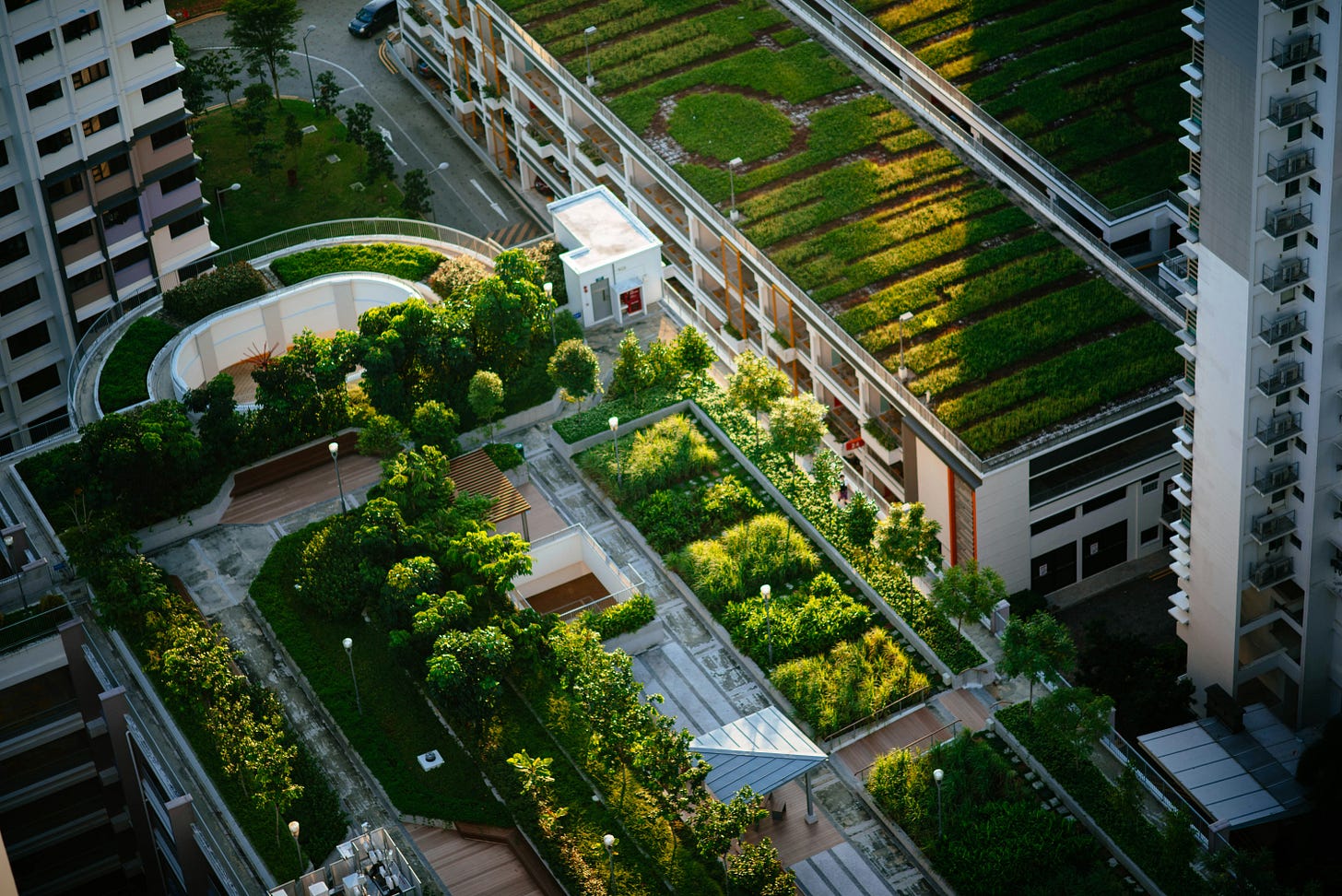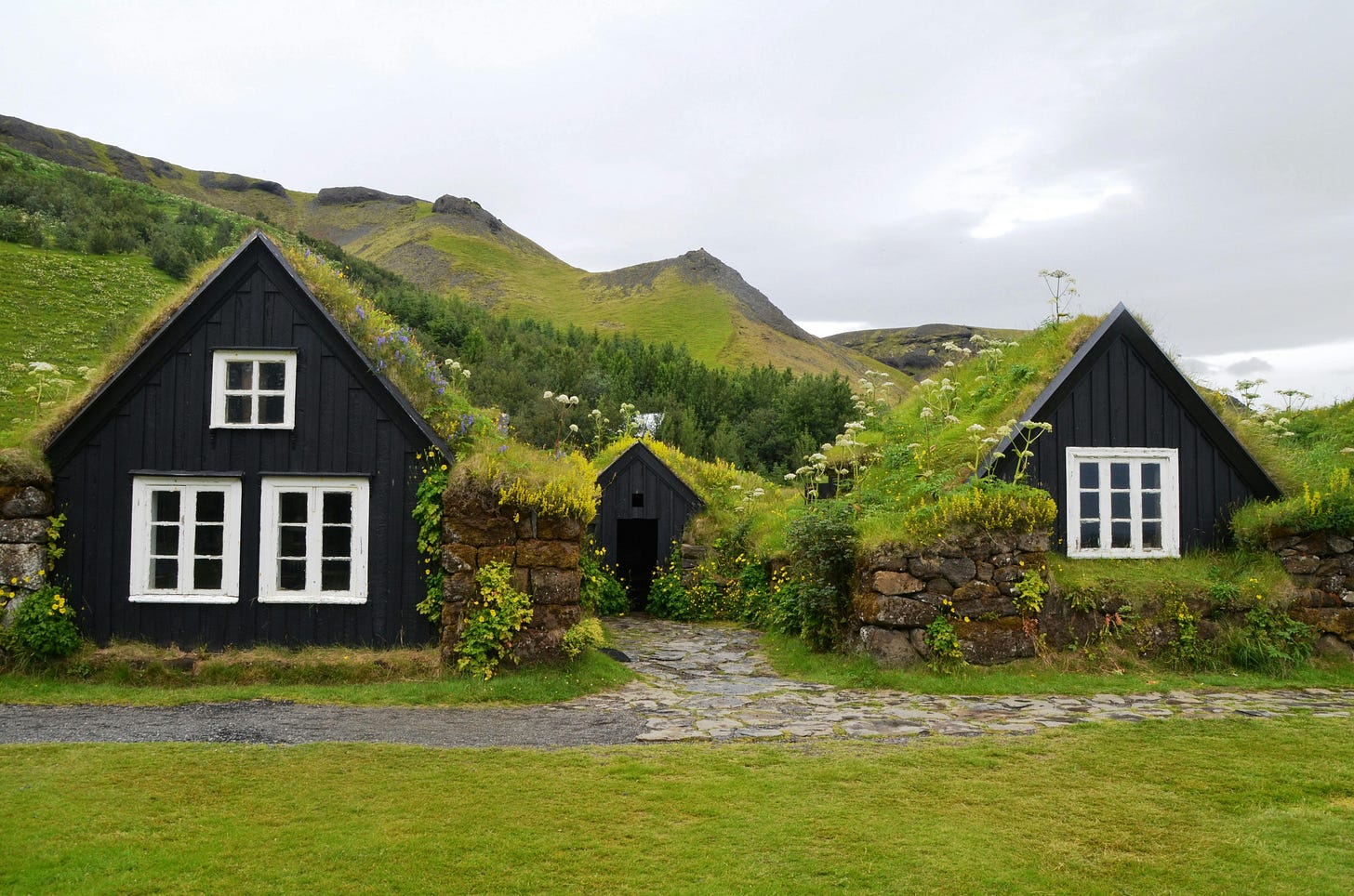Amsterdam Levels Up its Eco-Friendly Housing Game
You may have heard of sponge cities and green roofs, but now Amsterdam is creating blue-green roofs
Hiya!
I know there’s lots of doom and gloom going on these days, but a ton of really cool things are also happening, too. Hear me out; for instance, climate change is, understandably, one of the leading causes of rising global depression and anxiety rates, especially among youth.
Yet, at the same time, humans thrive when faced with a challenge — and climate change is one hell of a challenge. As the number of record-breaking weather catastrophes grows, the creativity and ingenuity of scientists, engineers, and students of all ages flourish as they develop solutions for a more sustainable way of life. Even entire cities are rising to the challenge, like Amsterdam, for example, which just leveled up the eco-friendly housing game.
Outdated Urban Designs
Most cities, especially in the West, were designed for climates that no longer exist. If you live in the United States, your city was designed for a climate from about 100 to 250 years ago when the goal was to create cities that are impervious to water.
But these designs are now failing because, as you know, water is a powerful force, and we’re getting a lot of it. As climate change increases, the warming atmosphere holds more moisture, leading to wetter storms that decimate our concrete and asphalt infrastructure.
Michael Kiparsky, Director of the Wheeler Water Institute at the University of California, Berkeley, explains to Wired’s senior staff writer, Matt Simon:
“Where once there were forests and fields and wetlands that would soak up the rain, these have been paved over and replaced with surfaces that do not absorb rain.”
So now, urban planners are changing things up and designing cities that work with nature rather than against it.
Sponge Cities
Many cities are turning to the “sponge city” concept. The idea has multiple names: Water Sensitive Urban Design (WSUD) in Australia and the Middle East, Sustainable Urban Drainage Systems (SuDS) in the U.K., and Natural Drainage Systems in Seattle.
Whatever you want to call it, these urban areas are designed to soak up water rather than wick it away. Not only do sponge cities reduce flooding, but they can funnel water to aquifers, which can be used during the increasingly drier seasons and droughts.
Green Roofs
Rooftops hold significant potential since they take up a substantial portion of space yet are highly underutilized. However, green roofs use this wasted space by turning rooftops into gardens with a layer of plant material to capture water when it rains, hydrate the plants, and slowly release any excess moisture through evaporation.
While structures require specific designs to handle the extra weight of green roofs, there are many benefits — only one of which is absorbing rainwater. The United States Environmental Protection Agency (EPA) states:
Green roofs can also help reduce building energy usage and noise levels while increasing the durability and lifespan of the roof compared to conventional roofs.
Green roofs and sponge cities are growing in popularity. Even individual homeowners are jumping on the eco-train with the “no grass” landscaping — filling their yards with native plants rather than grass to boost biodiversity.
Many urban areas are shifting toward these greener concepts, but Amsterdam is taking it even further by creating blue-green roofs.

Introducing Blue-Green Roofs
Green roofs are great for soaking up rainwater and boosting biodiversity, but blue-green roofs focus on capturing water by including extra infrastructure to store it, which can be used to flush toilets and water houseplants.
Like green roofs, blue-green roofs have a combination of shrubs, grasses, ferns, sedums, and other hardier plants on the roof that can survive high amounts of sunlight and have roots that ground them in windy conditions.
Like a green roof, below the plants is a filter that prevents the soil from getting into the layer below, usually the structure. However, in blue-green roofs, the next layer down is a storage unit for the water, which acts as flat rain barrels. Beneath that are additional barriers to prevent the water and plant roots from entering the structure.
A smart valve manages the water levels of the roof’s storage unit. So, when the weather forecast warns of a storm, the valve will open to empty the water tank to make room for the predicted downpour and limit the overflow into the surrounding area.
The blue-green roof concept is more than just an idea. The Resilience Network of Smart Innovative Climate-Adaptive Rooftops (RESILIO), just one such project in Amsterdam, has already transformed over 100,000 square feet of rooftops into blue-green ones, including 86,000 square feet of social housing buildings. Beyond RESILIO, blue-green roofs in Amsterdam are estimated to be closer to 500,000 square feet.
In his Wired article, Simon describes the blue-green roof system as “a sponge that the operator can wring out as need[ed].” Further, if an entire city had blue-green roofs, it would become malleable by strategically designating where excess water is used.
Yet, that’s just one of a growing list of benefits blue-green roofs can have, with or without being part of a sponge city. For instance, the added layer of water can save energy by keeping the top floors of buildings and homes cooler. Opting for indigenous plants could boost plant and insect biodiversity.
People may even be able to grow crops on their rooftops under solar panels, a process called agrivoltaics — which scientists are already experimenting with. Simon points out that theoretically, adding the blue-green roofing concept to agrivoltaics could make the solar panels more efficient because the evaporating water from the roof would cool the solar panels.
Caveat
As brilliant as the blue-green concept is, it’s not without challenges, the largest of which is the additional weight. The added infrastructure and organic material aren’t as big of an issue as the water is.
Water is heavy, especially when there’s a lot of it, and older buildings weren’t designed to accommodate such a heavy load. As we discussed earlier, most roof designs wick water away quickly, not collect it. So, many buildings would require a retrofit for the blue-green roof to succeed — which brings us to the second biggest challenge.
Cost. Similar to other eco-housing methods, materials and construction aren’t cheap, so only those who can afford it can do it. However, like technology, implementing sponge cities and green or blue-green roofs more widely can help bring costs down.
Still, these changes will remain expensive for many less affluent people. To help, cities could provide tax breaks to encourage homeowners to install a green or blue-green roof.
Some cities, including Pittsburgh, Pennsylvania, and Los Angeles, California, are already experimenting with something similar, such as taxes on impenetrable areas of a property, such as concrete, which are prone to backing up stormwater runoff. The taxes are to encourage landowners to include green spaces instead. Spaan points out:
“Our philosophy in the end is not that on every roof, everything is possible but that on every roof, something is possible.”
Perspective Shift
One of my favorite things about all is the remarkable creativity resulting from it. Still, while these eco-city designs feel modern and futuristic, they remind me of ancient ideas. Archeologists have discovered many ancient cities featuring advanced water systems with aqueduct storage units to sustain large populations.
These days, most cities look alike — full of concrete and tall buildings surrounded by sprawling suburbs. Culture is basically the only thing distinguishing one city from another. So, I am all for transforming modern cities into eco-friendly, sustainable ones and am excited to see what creative designs urban planners come up with.
As a reminder, you’re currently reading my free newsletter, Curious Adventure. If you’re itching for more, you’ll probably enjoy my other newsletter, Curious Life, which you’ve already received sneak peeks of on Monday mornings. The subscription helps me pay my bills so I can continue doing what I love — following my curiosities and sharing what I learn with you.
Also, if you enjoy my work and want to show me support, you can donate to my PalPal. Thank you for reading. I appreciate you.





This makes so much sense, especially for new construction. Thanks for the positive info.